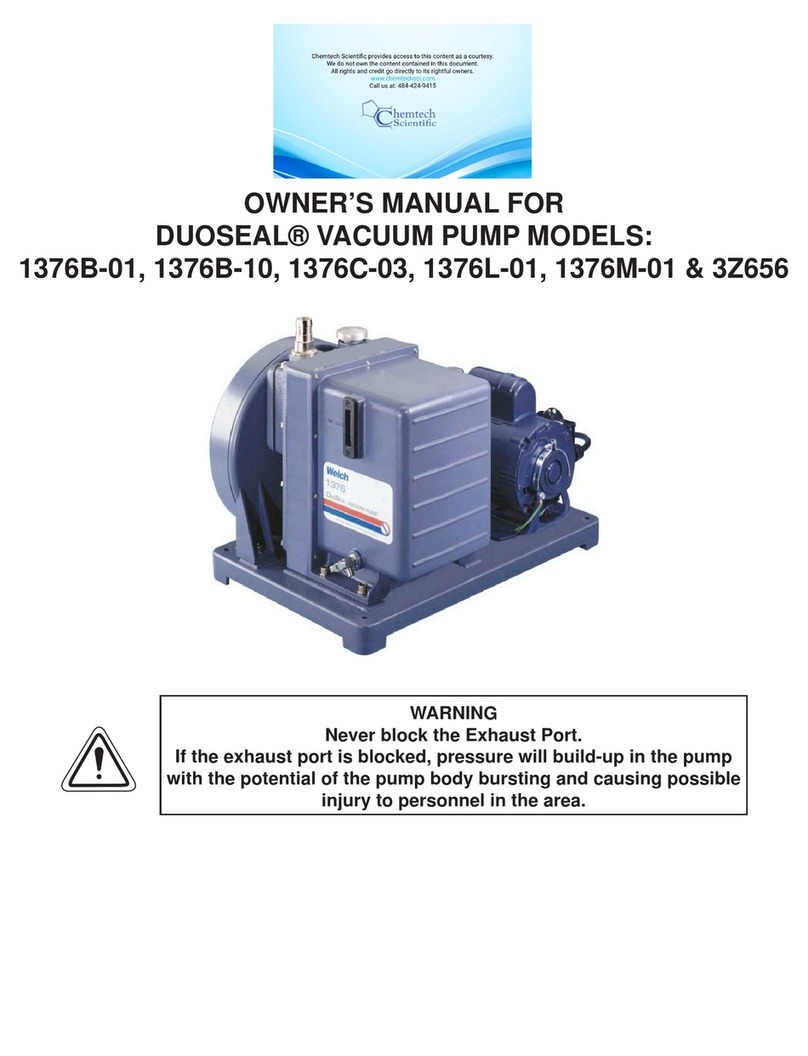Leaky vacuum systems, too large a vacuum chamber for pump size or high gas loads to the vacuum systems
are causes for extended runs of the pump at elevated pressure. If you need additional information, please contact
Welch Vacuum at 847-676-8800, extension 1, for further information and precautions.
2.22 Principle of Gas Ballast
2.221 Effects of Unwanted Vapor
Systems which contain undesirable vapors cause difficulty both from the standpoint of attaining desirable ultimate
pressures as well as contamination of the lubricating medium. A vapor is defined as the gaseous form of any
substance which is usually a liquid or a solid. Water, oil and a mercury vapors are three of the more common
vapors encountered in typical vacuum systems. When such vapors exist in a system, the vapors or mixtures of
gas and vapor are subject to condensation within the pump; the precipitated liquid may thus ultimately dissolve
or become emulsified with the lubricating medium. This emulsion is recirculated to the chambers of the pump
where it is again volatilized causing increased pressure within the system.
2.222 Presence and Removal of Condensate
Condensation takes place particularly in the compression stroke of the backing or second stage of a two-stage
pump. The compression stroke is that portion of the cycle during which the gas drawn from the intake port is
compresses to the pressure necessary to expel it past the exhaust valve. Condensation takes place when the ratio
between the initial pressure and the end pressure of the compression is high, that is, when the mixture of vapor
and gas drawn from the intake port is compressed from a low pressure to high pressure. By adding air though the
gas ballast valve to the mixture of vapor and gas being compressed, the pressure required for delivery past the
exhaust valve is reached with a considerably smaller reduction of the volume of the mixture; this, depending
upon the amount of air added, condensation of the vapor is wither entirely avoided or substantial reduced.
2.223 Pump Function With Gas Ballast
In a pump functioning on a contaminated system and operating without the gas ballast, compression within the
stage takes place in the normal manner until the saturation pressure of the contaminating vapor contained within
the mixture of gas and vapor is reached. The saturation pressure of water vapor is that pressure and corresponding
temperature at which the dew point of the vapor is reached and condensation occurs. The saturation pressure of
water vapor at an ambient temperature of 20°C is 17.5 Torr, while at 60°C, the approximate operating temperature
of a pump, the saturation pressure is 149 Torr. The external side of the exhaust valve is subjected to atmospheric
pressure. Consequently a compressive force somewhat greater than atmospheric pressure is required to open the
valve and permit expulsion of the gas. Sometime during increased compression of the mixture of gas
and
vapors, the saturation pressure of 149 Torr for the water vapor is reached and the vapor condenses. The
condensate is
then allowed to emulsify with the oil which is recirculated within the pump stages this providing continued
contamination of the system.
2.224 Pump Function With Gas Ballast
On the other hand, when ballast air at atmospheric pressure is supplied to the compression stroke by means of the
gas ballast, the partial pressure of the unwanted vapor becomes a very small part of the total pressure of the
mixture of gas, vapor and newly supplied air. The vapor is thus prevented from reaching its saturation pressure
corresponding to the temperature of the pump and is finally expelled form the pump as a vapor.
2.225 Controlled Ballast Flow
Some degree of variation in ballast flow may be obtained by the amount of opening applied tot he gas ballast.
Two or more turns of the gas ballast are sufficient to open it wide. With the gas ballast open, the sound of the
exhaust is similar to that of a pump operating against a large leak. Because of the increased pressure introduced
into the compression stroke, the pump must work a little hard to function, thus resulting in an increased
operating temperature of approximately 8°C over a prolonged period of time. Tests have shown that continuous
and prolonged operation for several weeks under these conditions is not injurious to the pump.






































